 One of the Many Waterfalls on the Hike |
Again, I rose early and went off to get the weather forecast from the transport coordinator again. He was in a rush, but managed to shout out to me, "It starts with this murk we have now, and gets progressively worse through the day." "Great!" I cursed, the complete opposite of yesterday's prediction.
The Tongariro Alpine Crossing would be pointless today, it would be a wet slog and I wouldn't see anything. I made a decision to stay for one more night, and dependant on the weather in the morning, make a decision as to whether to move on or not.
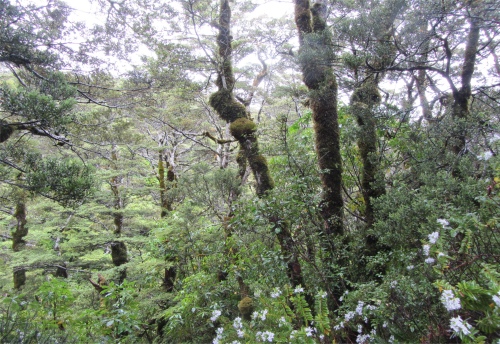 Mountain Beech Trees |
I set off briskly in the cool air, the mists throwing a grey cloak over the high ground and rendering the volcanoes invisible. The walk encompassed a wide range of landscapes: lush beech forest, tussock-shrublands, ancient lava flows, cascading streams, waterfalls and invisible mountain views.
 Some of the Flowers Encountered on the Hike |
Mountain beech can be found growing up to 1530m in the national park, giving the park the highest treeline in New Zealand. Reasonably large trees at lower levels, mountain beech become compact twisted dwarf shrubs at higher altitudes where they constantly brace themselves against the alpine winds. Like many good alpine survivors they grow in clusters, protecting themselves from wind and retaining daytime heat to survive the freezing night.
Mountain beech trees are often cloaked with a heavy layer of snow in winter. Their branches need to be flexible enough to droop under the weight of the snow but strong enough not to break. This elasticity also enables the trees to survive high winds.
Beech trees survive many natural catastrophes. The light-loving seedlings quickly take advantage of gaps in the canopy created by landslides, windthrow and avalanches. Unfortunately they do not have an efficient method of dispersing seed long distances. It can take decades, even centuries, for mountain beech forest to re-establish after fire.
As I climbed out of the beech into tussock land, I spotted the top of the Taranaki falls from a distance. It took me just a few minutes to reach the falls, the Wairere Stream plummeting 20m into a boulder-ringed pool. The falls were in full spate after the overnight downpours. A roar emanated from the base of the falls, with spray hissing out from the boiling cauldron below. In sympathy, as I stopped to take a photograph, a light rain started to fall, sending a couple standing nearby into a panic as they haphazardly searched their backpacks for waterproofs.
The track climbed and curled around above the falls, and being a mad Englishman, I deviated across the rocks to peer over the edge. This provided a good photo opportunity for people who had just arrived at the base of the falls. They could now compose their pictures with a human in the frame to give an idea of scale. I gave them a wave, they waved back, but the roar of the water made verbal communication impossible.
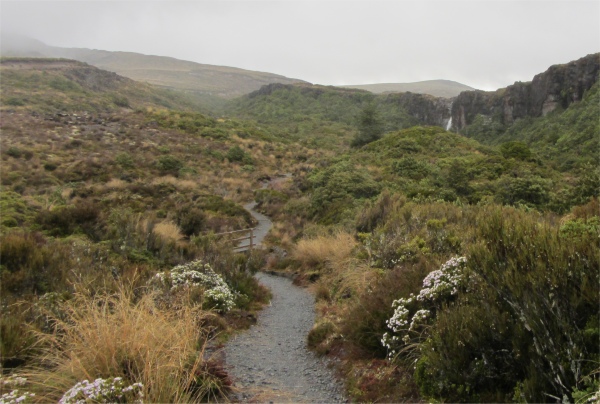 Tussock-Shrublands Leading to Taranaki Falls in the Distance |
The family were doing a lightening 12 day tour of New Zealand, travelling mostly by rail, and staying in hotels. "My daughter doesn't do camping," the chap said as an aside. Their strategy was simple, two days in each place they visited. The next ports of call on their agenda were Wellington, Milford Sound and Queenstown, before heading back home. For their activity at Queenstown, I recommended the Skippers Canyon trip and the ride on a jetboat up the Shotover River. "I read about that, and it seemed fun. Right, I'll take the gals on that," he enthused, thankful that he now had a plan worked out for one of his stopovers.
"I work as an electrical contractor, mostly in the power generation business," he volunteered, "though I spend most of my time on the phone nowadays. Unlike you guys in Europe, Americans normally get just two weeks holiday per year, though I cheat a little." I wondered how he cheated, but thought it wise not to ask. That explained his flying visit. He was staggered by my four month stints of travel, and he listened intently when I described my Rockies trip. It seemed like a whole new lifestyle to him. "How are ya staying, in a campervan or tent?" he asked. "No, I live in a car," I told him, and explained the set up. "So you can pull in anywhere?" he enquired. "No, not now, Freedom Camping is forbidden now," I replied. I had to explain the concept of Freedom Camping to him, pointing out the similarities with Dispersed Camping in the US. He had never heard of the latter neither. Perhaps it is not just the daughter who is not into camping.
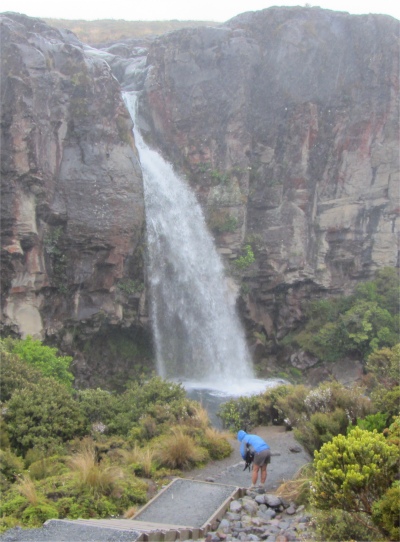 Looking Down to Taranaki Falls - in the Rain Of Course |
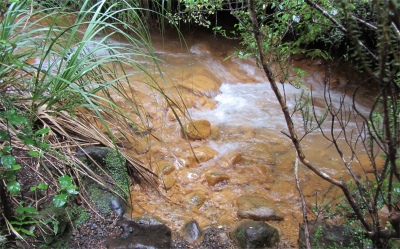 Golden Rapids |
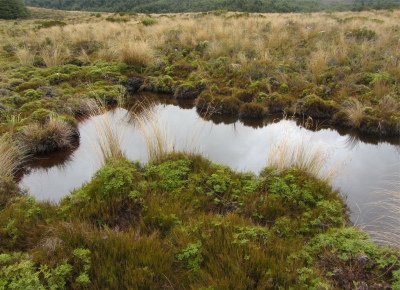 Alpine Bog |
"What's this place like in winter?" I asked. "That's the busy season - full of skiers. The campsite is packed solid from July to October. There won't be any tents around, but it will be full of campervans who just plug into the power outlets, so they keep warm enough. Some people keep caravans here throughout the season, and use them as a base for the weekends when they come skiing from the cities. Sometimes the road gets cut off, so we have to be self-sufficient," she replied.
With boredom and a bout of the shivers setting in, I opted to take on another hike, namely the Silica Rapids Walk. Rivers and streams in Tongariro National Park often carry minerals and chemicals that influence the acidity and colouring of the water and river beds. This is due to the chemical makeup of volcanic rock.
 Silica Rapids |
The turbulence of the water affects the amount of deposit. In high flows less minerals are deposited than in low flows, resulting in a river bed that changes in colour. Turbulence also played another role. As the water becomes more turbulent it loses carbon dioxide. This creates ideal conditions for alumino-silicate to be deposited.
At a higher altitude I encountered alpine bogs. Bogs and wetlands are extremely fragile. In this environment it can take plants many years to establish. Poor drainage, and low oxygen levels contribute to the soil's acidic and peaty nature as an underlying thick blanket of ash creates a barrier, holding water close to the ground surface.
Small tarns were visible, typical of the wet western slopes of Mount Ruapehu.
Alpine bogs contain unique flora. Insect eating sundews, lichens, sedges and tussocks colonise these wet areas.
As on the Taranaki Falls hike I undertook in the morning, in the area I was now walking, the environment of poor drainage, cold temperatures and poor soil fertility, mountain beech predominated.
Native mistletoe uses mountain beech as a host, taking from it water in order to survive. Often I came across metal bands around host trees to protect the endangered species from possum browsing.
As I walked to a higher tussock based level, it became apparent that the ash soils, loosely bonded to underlying lava rock, cannot withstand the forces of water, wind and ice. While the soils are more stable when cloaked by vegetation, the smallest disturbance or damage to this cover can accelerate the erosive process and strip the surface to expose the bare rock.
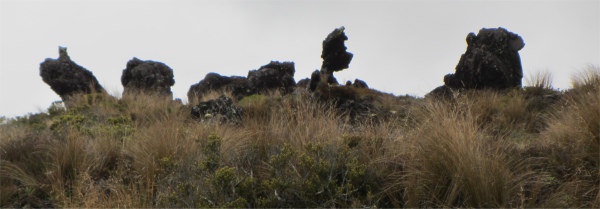 Lava Outcrop |
The track crossed a lava flow, which originated from the now extinct Iwikau Crater on the summit of Mount Ruapehu. Dating back less than 15,000 years ago, outcrops of lava could be clearly seen.
Red tussock was a predominant species in this area and is one of the first native plants to establish bare areas such as lava flows and ash deposits. Red tussock and mountain inaka shrublands are the most common communities in the sub-alpine zones of the national park.
As I made my way across the tops to Bruce Road, which would be my route back to camp, the heavens opened. Within minutes I was saturated from the waist down. Even my boots were filling up with the water running down my legs. When I reached the road, I hadn't the heart to try and hitch down to the campsite; I would turn the Good Samaritan's car into a puddle. Almost 1.5 hours later, wading through raging rain, I reached the camp. I grabbed some dry clothes, put them into a bag, and sought refuge in the showers. I must had stood under the hot jet of water for about 40 minutes; bliss.
Once back to my waggon, I switched the engine on and set the heater to fully on, and set about trying to dry my boots out, and also some of my wet clothes; if I left them soaking with the rest of my laundry, they would soon start to smell.
I mustn't grumble, at least I got in two decent hikes today.
